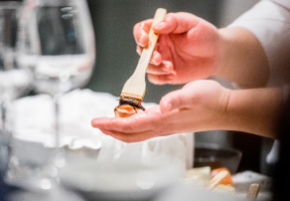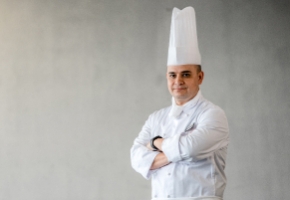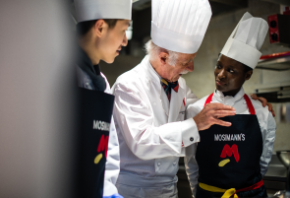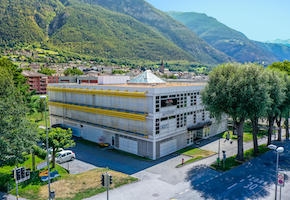- About
- Programs
- Campus Life
- Career Services
- Admissions
- News & Events
- Alumni
What Is the Maillard Reaction? The Science of Flavor
Master the science of the Maillard Reaction and explore how this cooking process enhances taste, texture, and visual appeal in countless dishes.
Key Takeaways
- The Maillard reaction creates the rich flavors, aromas, and browning that elevate many cooked foods.
- High heat, low moisture, and the presence of proteins and sugars are essential to trigger this reaction.
- The Maillard reaction happens in multiple stages, each building on the last to develop complex flavors and appealing colors in food.
- Understanding and controlling the Maillard reaction helps chefs transform simple ingredients into memorable dishes.
There’s something magical about the smell of sizzling steak, golden-brown toast, or fresh cookies emerging from the oven. That rich aroma, the deep color, and the irresistible flavor all come from a powerful transformation known as the Maillard reaction.
It happens every time food turns golden and delicious in the pan or on the grill. Behind the scenes, this natural process brings together heat and protein to create hundreds of new flavor compounds. You may not see it, but it’s working hard to make food taste amazing.
What Is the Maillard Reaction?
The Maillard reaction is a chemical reaction that happens when proteins and sugars in food meet heat. It’s what gives browned food its distinctive flavor, aroma, and color. Scientifically speaking, it’s a form of non-enzymatic browning, which means it doesn’t rely on enzymes to change the food’s color and taste.
This process is different from caramelization, which only involves the breakdown of sugars. The Maillard reaction requires both amino acids (the building blocks of proteins) and reducing sugars to initiate the process.
This tasty transformation was first described in 1912 by French chemist Louis-Camille Maillard. While trying to understand how amino acids interact with sugars, he ended up unlocking one of the most delicious secrets in cooking.
The reaction typically begins around 140°C (285°F) and intensifies at higher temperatures. You’ll see it when searing meat, baking bread, roasting coffee, or toasting marshmallows.
As the heat rises, a cascade of new flavor molecules begins to form, creating that deep, rich, savory taste we all love. It’s the science behind the sizzle and the reason food tastes so satisfying.
Why the Maillard Reaction Matters in Culinary Arts
Start Your Culinary Journey
Learn the art of cooking in a world-class environment
The Maillard reaction plays a major role in transforming simple ingredients into restaurant-quality dishes. It helps bring out subtle qualities in meat, bread, vegetables, and even sauces.
With the right amount of heat and timing, this reaction creates a more developed taste that feels polished and professional. What starts as an everyday cut of meat or slice of bread can turn into something that feels crafted and carefully prepared.
The Maillard reaction is one of the techniques that separates casual cooking from serious culinary work. It allows chefs to add complexity and balance through controlled browning, resulting in a more refined finish without adding extra ingredients.
Culinary students who understand how this reaction works are better prepared to adjust heat, choose the right cooking technique, and time each step with precision. At Culinary Arts Academy Switzerland (CAAS), the Maillard reaction is one of many techniques taught in a practical, approachable way.
With guidance from expert chefs and real-world kitchen experience, students learn how to use these methods to bring skill and creativity to everything they prepare. It is part of what turns practice into artistry and ingredients into exceptional dishes.
Key Phases of the Maillard Reaction
The Maillard reaction isn’t just a single step but rather a chain of chemical events unfolding in phases. Each one triggers new changes, building on the last to deepen taste, develop aroma, and create the browning we see on cooked food. This layered process is what makes meals more flavorful and satisfying.
Initial condensation
The Maillard reaction begins with a heat-activated stage where amino acids interact with reducing sugars. These two components react to form unstable structures known as glycosylamines.
This initial condensation marks the start of the transformation, setting the stage for all the flavor and aroma development that follows. It requires temperatures high enough to cause molecular motion, usually seen in searing, baking, or roasting.
Though the reaction seems simple at this point, the molecules involved are already beginning to rearrange and shift. As soon as glycosylamines are formed, they begin to move into the next phase, where more recognizable flavor-related compounds take shape.
This early reaction is silent but powerful. It doesn’t create flavor directly, but it launches a complex series of steps that will eventually bring out the color, texture, and smell we associate with expertly prepared food. The moment sugars and proteins meet heat, this fascinating process begins.
Amadori rearrangement
Once glycosylamines are formed in the initial step, they quickly undergo a structural shift known as the Amadori rearrangement. During this stage, the glycosylamines rearrange into more stable compounds called Amadori products.
These compounds are less reactive than their earlier form but serve as a critical transition point in the Maillard reaction. This phase bridges the simple beginnings with the more dynamic steps that follow, setting the chemical groundwork for deeper changes in flavor and aroma.
Although you still won’t see major visible transformations at this point, the food is quietly moving closer to the golden color and richer taste we expect from high-heat cooking. The Amadori compounds act like a gateway. Their presence leads to a wide variety of smaller, more reactive molecules that form later.
Understanding this phase helps culinary professionals anticipate how flavor will evolve, even before any browning appears on the surface of the food.
Degradation of Amadori products
In the next phase of the Maillard reaction, Amadori compounds begin to break down, producing a range of smaller, highly reactive molecules. These include carbonyl and dicarbonyl compounds, which play a key role in flavor formation. This phase opens the door to a whole range of chemical activity.
As the Amadori compounds break down, they release substances that will soon take on entirely new forms. These intermediate products act as the building blocks for taste, acting behind the scenes to shape what we will eventually smell and taste in the final dish.
Some of these compounds are volatile, meaning they easily turn into gases and contribute to the mouthwatering aroma of cooked food. This is the moment where things truly start to shift. The breakdown of Amadori products turns a quiet reaction into a much more active one, filling the pan or oven with early signs of something delicious taking shape.
Formation of advanced products
After the degradation phase, the Maillard reaction shifts into one of its most flavorful moments. The reactive molecules created earlier begin forming complex compounds like heterocyclic structures, aldehydes, and ketones. These are the heavy hitters when it comes to developing unique aromas and taste profiles in cooked food.
Heterocyclic compounds, for example, are often responsible for roasted, nutty, or meaty flavors. Aldehydes and ketones contribute fruity, buttery, or even earthy notes depending on the ingredients involved. This phase is where the diversity of flavor really comes to life.
Depending on the combination of proteins and sugars and the amount of heat applied, the range of possible compounds is nearly endless. The result is a signature taste that varies from food to food, which is what makes a grilled steak taste different from a toasted marshmallow. During this phase, chefs can use timing and technique to more deeply affect flavor.
Polymerization and browning
As the Maillard reaction reaches its final phase, the smaller compounds formed earlier begin to link together, creating large, dark-colored structures called melanoidins. These are responsible for the brown appearance of seared meat, crusty bread, and roasted vegetables.
The color is what signals that the food has undergone a full transformation. Along with color, melanoidins add subtle depth to flavor and influence texture. A well-browned crust, for example, gives bread its satisfying crunch, while a seared surface locks in moisture and adds structure to meats.
This final phase also provides important cooking cues. The shift in color and texture lets chefs know when a dish is nearing completion, helping them achieve consistent results. Although the science happens on a microscopic level, the visual and sensory effects are unmistakable. Polymerization brings the process full circle, turning invisible changes into something you can see, touch, and taste.
How to Trigger the Maillard Reaction
To unlock the Maillard reaction, you need the right environment. This process doesn’t happen by chance. It takes a few key conditions working together to bring out the full range of flavors. These include:
- High heat: The reaction starts around 140°C (285°F) and becomes more active as temperatures increase.
- Low moisture: Excess water cools the surface and slows the reaction. Patting meat dry before searing or spacing vegetables on a roasting pan helps.
- Proteins and sugars: These are the two building blocks of the flavorful transformation, and therefore are a must-have.
- pH levels: A slightly alkaline surface speeds up the reaction. Some chefs use a light baking soda solution on certain ingredients, such as onions or mushrooms, for this reason.
When everything lines up, the Maillard reaction creates a spectrum of flavor notes: nutty, roasted, meaty, and even sweet. The exact outcome depends on variables like heat level, ingredient type, and pH. By adjusting these, chefs can shape the flavor profile and create dishes with depth and balance.
Real-World Culinary Applications
You don’t need a science lab to see the Maillard Reaction in action. It shows up every time you brown a steak, roast vegetables, toast a slice of bread, or pull a tray of cookies from the oven. The name might sound technical, but the results are familiar: the flavor, color, and aroma that make cooked food irresistible.
Searing meat
The Maillard reaction is a key step in creating meat that is both tasty and satisfying, turning a simple cooking moment into something more complete, full of depth and aroma.
When a piece of steak hits a hot pan, the proteins and natural sugars on its surface begin to react with the heat. This creates a flavorful brown crust that gives the meat a rich taste and appealing look.
To help this reaction along, it’s important to start with a dry surface. Moisture on the meat creates steam, which lowers the temperature and slows the browning process. A hot pan or grill is also important. The higher the heat, the faster the reaction begins. This helps form a flavorful outer layer while keeping the inside juicy and tender.
Baking bread and pastries
That golden crust on fresh-baked bread or flaky pastries? It’s the Maillard reaction at work. As dough heats in the oven, the proteins in flour and the sugars (either natural or added) begin to interact. The result is a beautifully browned exterior that’s both flavorful and visually appealing.
This reaction gives bread its crisp crust and adds a hint of toasted sweetness to pastries. Ingredients like milk, butter, or egg wash can enhance browning because they contain both proteins and sugars, speeding up the process and enriching the final color and flavor.
Even small changes, such as the amount of sugar in a dough or the oven temperature, can influence how the crust forms. For bakers, understanding this reaction helps in creating loaves and treats that look as good as they taste.
Roasting vegetables
Vegetables that are roasted develop flavors that aren't present in raw or steamed forms. The Maillard reaction is largely responsible for that change.
When starchy vegetables like potatoes, carrots, or squash are exposed to high heat, their natural sugars and amino acids begin to react. The result is deeper color, richer taste, and a crisp-tender texture.
Using a bit of oil helps promote even browning. Oil increases heat transfer and prevents vegetables from steaming instead of roasting. Spacing them out on the baking sheet also matters, as it allows heat to circulate and avoids moisture buildup.
As vegetables roast, the Maillard reaction draws out sweet, nutty, and roasted notes that elevate them from a side dish to something truly craveable. It’s a simple method with flavorful results.
Coffee and cocoa
Before coffee beans and cocoa nibs reach your cup, they undergo a powerful transformation through roasting. During this process, the Maillard reaction is responsible for developing the deep, rich aromas and flavors we associate with a quality brew or bar of chocolate.
Heat causes the amino acids and sugars inside the beans to react, creating hundreds of aromatic compounds. These compounds give each coffee or chocolate its distinct profile, from fruity and floral to earthy and smoky.
Small differences in roasting temperature or duration can shift the flavor dramatically. That’s why roast profiles are carefully controlled in both industries. The Maillard reaction not only builds flavor but also helps define the unique identity of different beans and blends. It turns raw ingredients into comforting, flavorful favorites enjoyed all over the world.
Master the Maillard Reaction in Culinary School
The Maillard reaction plays a vital role in the science of flavor and the art of cooking. It helps chefs create dishes that are not only visually appealing but also full of character and complexity. Understanding how and when this reaction occurs gives culinary professionals an edge in the kitchen, allowing them to bring out the best in every ingredient.
At CAAS, students explore the principles behind techniques like this and learn how to apply them with purpose and precision. With guidance from expert chefs and hands-on experience in state-of-the-art kitchens, our students build a strong foundation in both theory and practice. Explore our programs and take the first step toward mastering the skills that set true culinary professionals apart.
Frequently Asked Questions
What types of food undergo the Maillard reaction?
Meats, breads, roasted vegetables, coffee, and cocoa all undergo the Maillard reaction when exposed to high heat.
What is the difference between caramelization and the Maillard reaction?
Caramelization involves the breakdown of sugars alone, while the Maillard reaction happens between sugars and proteins.
Can the Maillard reaction be reversed?
No, it’s a one-way chemical process that permanently changes the structure and flavor of food.
How does sous vide cooking affect the Maillard reaction?
Sous vide alone doesn’t trigger the reaction due to low temperatures, but searing the food afterward activates it.
Interested in studying at CAAS? Download our brochure to learn about our programs!



























